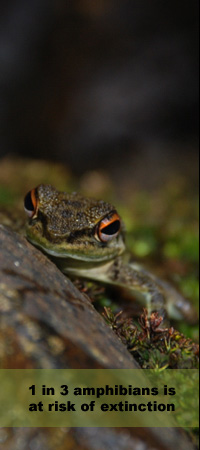Importance in culture and traditions
Amphibians have been playing an important role in tales, drawings, paintings, and sculptures in many countries. In Korea, amphibian tales and drawings are often used to portrait an intelligent person of good mind. During the Goguryeao dynasty (BC58-AD668), toad was described as the god of the moon in drawings painted on the wall of an old tomb. In Japan, the frog is usually seen as a symbol of good fortune associated with magical powers. Poems about frogs have been written around the world. For example, the French poem “La mare aux grenouilles” (the frog pond) of Maurice Rollinat (1877) depicts the author’s amazement for frogs. In Europe, salamanders were considered for a long time like a diabolic animal! For example, by killing salamanders, a person would get 100 days of indulgence and even gold coins during the Middle Ages. During the same time, toads were associated with the devil. However, during the Merovingien Dynasty (1600s), toad was a symbol of eternity.
Today, there are several frog festivals around the world. In China, during the frog festival the Zhuang people of Guangxi capture one frog, then honor it, and finally bury it to ensure good weather and harvest for the following year. Photographs and drawings of frogs are also used in many countries for advertisements, books, and video games.
Importance in medicine
More than 73 amphibian species are known to have some kind of medicinal values. The skin of frogs and toads has been used for medicine by many cultures since ancient times. For example, in the Korean culture, burning Japanese Treefrog (Hyla japonica) oil was believed to heal wounds, whereas the Gold-spotted Pond Frog (Rana plancyi chosenica) has been prescribed for fewer, weakened immune system, and to cure infectious diseases from wild animals.
Each amphibian species has its own protective compounds against predators and microorganisms. Compounds include amines, alkaloids, and peptides. They play as poisons, antibiotics, and pain relievers. Several hundred of amphibian antimicrobial peptides have been isolated from amphibian species. Peptides may be active against a broad spectrum of pathogens and have significant potential application for our health and conservation of other species. For instance, the peptide caerin 1.1 from Litoria caerulea inhibits growth of cancer cells, viral infection of target cells, prevents growth of malaria parasite, and kills nematodes. Amongst the known alkaloids found in frogs, the alkaloid epibatidine from the endangered Ecuadorian frog Epipedobates tricolor is a potent non-addictive analgesic considered to be 100 to 200 times more effective than morphine
In many countries, amphibians are still used in traditional medicines often to meet primary health needs. More than 30 species of amphibians have been recorded in Traditional Chinese Medicine alone. In Korea, a commercial medicine for athlete’s foot is made from toad skin secretions. In Mexico, the endangered Axolotl Ambystoma mexicanum is believed to provide remedies for respiratory aliments such as bronchitis. Losing more amphibian species (we lost about 100 species already!) would have terrible impacts on our current and future applications for human health.
Regeneration of tissues and organs by newts and salamanders
Unlike nearly all vertebrates, newts and salamanders (called urdeles) have the ability of regrowing tissues (e.g., hearth muscle) and organs such as complete limbs, jaws, and tails. The first study on amphibian regeneration was conducted by Lazzaro Spallanzani in 1768. In a newt or salamander, following the loss of a limb, a new one can be grown in about three months. Many genes that control this process have been identified also in human beings. They may offer a great hope for understanding how we may be able to unlock our own latent ability to regenerate lost cells, tissues, and maybe even organs.
Frozen frogs
Five species of frogs are known to survive after being frozen solid. Those frog species are the Eastern Gray Treefrog (Hyla versicolor), Cope's Gray Treefrog (Hyla chrysoscelis), Spring Peeper (Pseudacris crucifer), Midland Chorus Frog (Pseudacris triseriata), and Wood Frog (Rana sylvatica). In the case of the wood frog, its heart ceases to beat for up to several weeks. The frog’s capability to survive frozen environment has drawn the attention of scientist involved in human organ transplantation.
Frog glue
The Crucifix Frog (Notaden bennetti) from Australia spends nine months of the year living underground in dried mud, emerging after heavy rains. Its sticky skin protects the frog against predators including biting insects. New research has shown that the sticky adhesive secreted from the crucifix frog can help with shoulder rotator cuff repair. The unique properties of this frog glue (strong, flexible and sets in water) may ultimately lead to its use as an adjunct to rotator cuff repair in humans.
Importance in the environment
Amphibians are one of the main links in many ecosystem food webs. Often unseen, they can be quite abundant in some habitats. In temperate and tropical regions, amphibian can exceed all other terrestrial vertebrates such as birds, mammals, and reptiles. Amphibians including their larvae are important predators of invertebrates. Removal of amphibians from particular habitat can have drastic consequence by increasing insect populations. Through metamorphosis, many species of frogs and salamanders are a link of transfer of nutrient from aquatic systems to terrestrial ones. Therefore, removing amphibians from a particular habitat can affect drastically algae communities, invertebrate populations, predator dynamics, leaf litter decompositions, and nutrient cycling. Preserving amphibian diversity is an important component for living in a healthy environment.
Amphibians are beautiful
The diversity of colors, body shapes of amphibians is remarkable. Mantella frogs are famous for being the world’s most colorful animal species. The endangered Venezuelan yellow frog (Atelopus carbonerensis) is fully covered by a yellow sticking color. Colors can vary greatly anonght individuals within a single species. For example the Oriental fire-bellied toad (Bombina orientalis) has drastic color differences within a single population. Individual toads can be covered by dark grey or a vivid attractive green with few patches of black. The sheer diversity of form provides an endless aesthetic treat for the observer. However, one of the most appealing characteristics of amphibians is their calling during breeding season. Everybody, remember and often miss the chorus of the common treefrog species (Hyla sp.).
Continue on page 7
|
|

Les amants trépassés, anonymous painter. Toads were associated with the devil during the Middle Ages of European history.
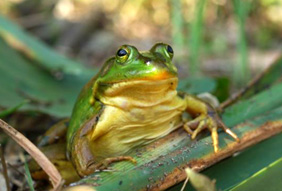
In Korea, the gold-spotted frog (Rana plancyi chosenica) used to be prescribed for fewer and weakened immune system. © 2009 Pierre Fidenci
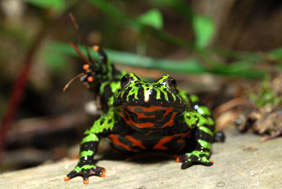
The oriental fire-bellied toad (Bombina orientalis) produced peptides in its skin that may lead for new human medicines. © 2009 Pierre Fidenci
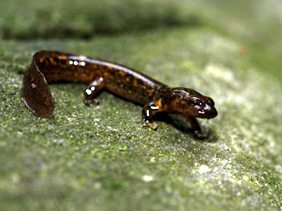
Salamanders like Onychodactylus fischeri from Korea plays a important role in the transfer of nutrient from aquatic systems to terrestrial ones. © 2009 Pierre Fidenci
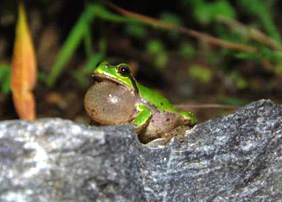
The beautiful chorus of the Japanese treefrog (Hyla japonica) is used for movies. © 2009 Pierre Fidenci
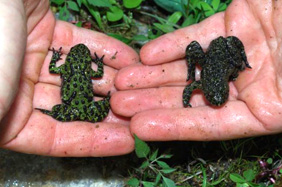
Each oriental fire-bellied toad (Bombina orientalis) displays a variety of colors. 2009 Eunkyung Chae
|

